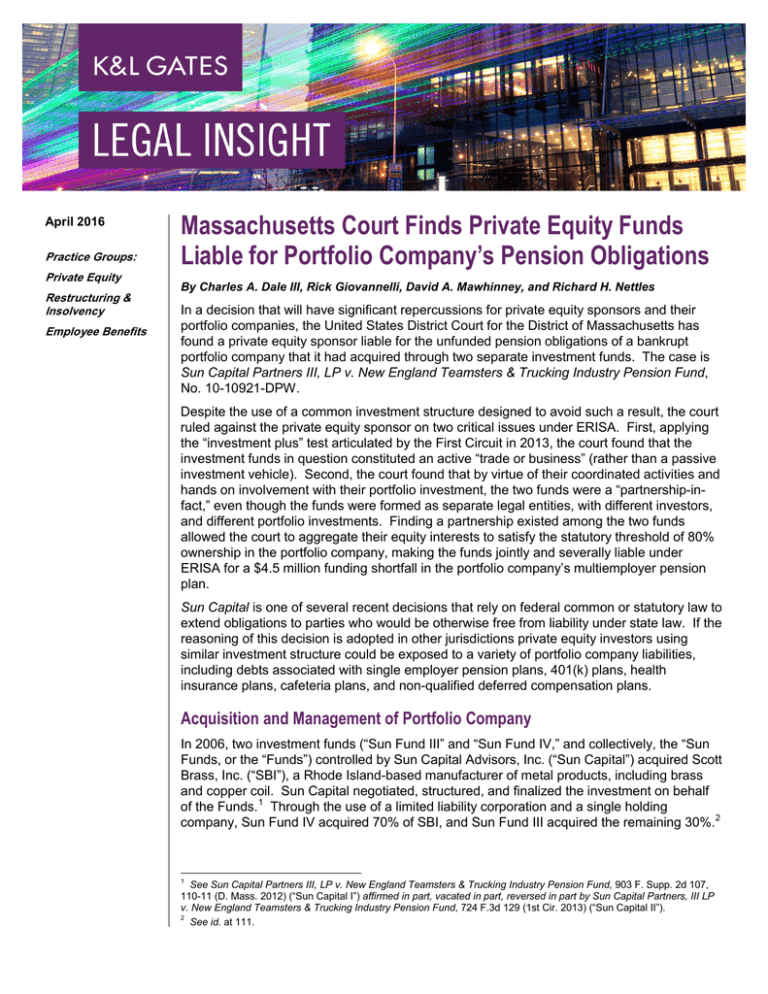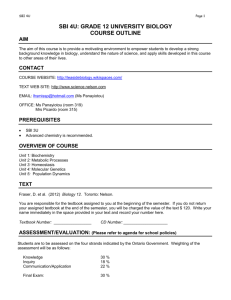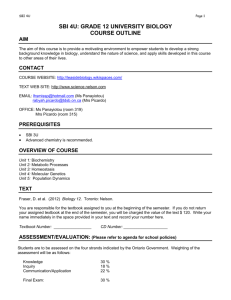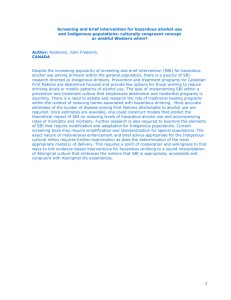
April 2016
Practice Groups:
Private Equity
Restructuring &
Insolvency
Employee Benefits
Massachusetts Court Finds Private Equity Funds
Liable for Portfolio Company’s Pension Obligations
By Charles A. Dale III, Rick Giovannelli, David A. Mawhinney, and Richard H. Nettles
In a decision that will have significant repercussions for private equity sponsors and their
portfolio companies, the United States District Court for the District of Massachusetts has
found a private equity sponsor liable for the unfunded pension obligations of a bankrupt
portfolio company that it had acquired through two separate investment funds. The case is
Sun Capital Partners III, LP v. New England Teamsters & Trucking Industry Pension Fund,
No. 10-10921-DPW.
Despite the use of a common investment structure designed to avoid such a result, the court
ruled against the private equity sponsor on two critical issues under ERISA. First, applying
the “investment plus” test articulated by the First Circuit in 2013, the court found that the
investment funds in question constituted an active “trade or business” (rather than a passive
investment vehicle). Second, the court found that by virtue of their coordinated activities and
hands on involvement with their portfolio investment, the two funds were a “partnership-infact,” even though the funds were formed as separate legal entities, with different investors,
and different portfolio investments. Finding a partnership existed among the two funds
allowed the court to aggregate their equity interests to satisfy the statutory threshold of 80%
ownership in the portfolio company, making the funds jointly and severally liable under
ERISA for a $4.5 million funding shortfall in the portfolio company’s multiemployer pension
plan.
Sun Capital is one of several recent decisions that rely on federal common or statutory law to
extend obligations to parties who would be otherwise free from liability under state law. If the
reasoning of this decision is adopted in other jurisdictions private equity investors using
similar investment structure could be exposed to a variety of portfolio company liabilities,
including debts associated with single employer pension plans, 401(k) plans, health
insurance plans, cafeteria plans, and non-qualified deferred compensation plans.
Acquisition and Management of Portfolio Company
In 2006, two investment funds (“Sun Fund III” and “Sun Fund IV,” and collectively, the “Sun
Funds, or the “Funds”) controlled by Sun Capital Advisors, Inc. (“Sun Capital”) acquired Scott
Brass, Inc. (“SBI”), a Rhode Island-based manufacturer of metal products, including brass
and copper coil. Sun Capital negotiated, structured, and finalized the investment on behalf
of the Funds. 1 Through the use of a limited liability corporation and a single holding
company, Sun Fund IV acquired 70% of SBI, and Sun Fund III acquired the remaining 30%.2
1
See Sun Capital Partners III, LP v. New England Teamsters & Trucking Industry Pension Fund, 903 F. Supp. 2d 107,
110-11 (D. Mass. 2012) (“Sun Capital I”) affirmed in part, vacated in part, reversed in part by Sun Capital Partners, III LP
v. New England Teamsters & Trucking Industry Pension Fund, 724 F.3d 129 (1st Cir. 2013) (“Sun Capital II”).
2
See id. at 111.
Massachusetts Court Finds Private Equity Funds Liable for
Portfolio Company’s Pension Obligations
Like many private equity funds, Sun Capital takes an active role in managing its portfolio
companies through board service and other advisory services. SBI was no exception.
Through affiliated management companies, Sun Capital placed its employees in two of the
three director positions at SBI, resulting in control of the SBI board. SBI paid management
fees for these services, which payments offset the fees that the Sun Funds would otherwise
owe to their general partners. The economic benefit derived by the Funds, together with the
control exerted over the affairs of SBI, were the central factors relied upon by the district
court to conclude that the Funds were in a de facto partnership and engaged in a trade or
business under common control with SBI, thus giving rise to control group liability under
ERISA.
SBI’s Insolvency and Demand for Unfunded Pension Obligations
At the time it was acquired by the Sun Funds, SBI was a member of the New England
Teamsters & Trucking Industry Pension Fund, a multiemployer pension plan (the “Pension
Fund”) regulated by the Pension Benefit Guaranty Corporation (“PBGC”) under the
Employee Retirement Income Security Act of 1974 (“ERISA”)3 as amended by the
Multiemployer Pension Plan Amendment Act of 1980 (“MPPAA”). 4 Multiemployer plans are
typically maintained by labor unions in a particular industry under collective-bargaining
agreements with two or more employers within that industry. Multiemployer plans pool
contributions, benefits, and risks for the contributing employers’ unionized workers, without
burdening each member business with the need to establish a complex human resources
organization. When an employer ceases contributing to the plan, ERISA determines that
employer’s proportionate share of any funding shortfall to the plan, referred to as its
“withdrawal liability.” ERISA imposes the withdrawal liability jointly and severally on each
“trade or business” that is under “common control” with the withdrawing employer. 5
In 2008, as the price of copper declined, SBI began to experience severe financial distress.
It withdrew from the Pension Fund in the fall of 2008, went out of business, and entered
bankruptcy. 6 At the time that it withdrew from the Pension Fund, SBI incurred $4,516,539 in
withdrawal liability. The Pension Fund demanded payment from the Sun Funds, claiming
that the funds were in an active “trade or business” and had formed a joint venture or
partnership that was under “common control” with SBI, and therefore were jointly and
severally labile to the Pension Fund under ERISA. 7
The First Circuit’s “Investment Plus” Test to Find a “Trade or Business”
The Sun Funds sued the Pension Fund in the United States District Court for the District of
Massachusetts seeking a declaratory judgment that the Funds were not liable for SBI’s
withdrawal liability. 8 The district court entered summary judgment for the Sun Funds finding
that because the Sun Funds were “simply pools of investment capital” without employees or
office space, they were not “trades or businesses” and, therefore, could not be liable for
3
4
5
6
7
8
29 U.S.C. §§ 1001-1461.
29 U.S.C. §§ 1381-1461.
See 29 U.S.C. § 1301(b)(1).
See Sun Capital I, 903 F. Supp. 2d at 112.
See id.
See id.
2
Massachusetts Court Finds Private Equity Funds Liable for
Portfolio Company’s Pension Obligations
SBI’s withdrawal liability. 9 On appeal, the First Circuit framed the issue as whether there
was “mere passive investment to defeat pension withdrawal liability” and concluded that an
“investment plus” analysis should be used to evaluate whether the Sun Funds were “trades
or businesses.” 10 While the First Circuit saw “no need to set forth guidelines for what the
‘plus’ test is,” it found sufficient facts to conclude that Sun Fund IV was sufficiently involved in
and derived economic benefits from SBI to be considered a “trade or business.” 11 The First
Circuit remanded the case to the district court to determine whether Sun Fund III was also a
“trade or business” under the “investment plus” test. Because the district court had not yet
reached the issue, the First Circuit also directed the lower court to determine whether both
Funds were under “common control” with SBI, such that the entities would be considered a
single employer for the purposes determining their withdrawal liability.
District Court Finds a “Trade or Business” and a “Partnership-in-Fact”; Private
Equity Sponsor Found Liable
On remand, the district court closely examined the ownership and managerial roles played
by the Sun Capital entities, including the benefits derived by each Fund from the payment of
management fees by SBI to affiliates of Sun Capital. Finding economic benefits not enjoyed
by mere passive investors (i.e., the management fees payable by SBI) and a coordination of
activities giving rise to a “partnership-in-fact” between the Funds, the district court concluded
that the Funds and SBI should be considered a “single employer” engaged in a “trade or
business” under ERISA and thus share SBI’s withdrawal liability jointly and severally.
A. Sun Funds Derived Economic Benefits from SBI in the Form of Fee Offsets and Fee Offset
Carryforwards
The Sun Funds’ general partners were entitled to an annual management fee (the “GP
Management Fee”) from each Fund, calculated as a percentage of the aggregate capital
commitments from the Fund’s limited partners or the Fund’s invested assets. 12 These GP
Management Fees could be reduced, or eliminated entirely, by other fees that were paid by
directly by the portfolio companies (e.g., SBI) to the general partners (the “Management Fee
Offsets”). 13 Specifically, Sun Capital Partners Management IV, LLC (“SCP Management”) (a
subsidiary of Sun Fund IV’s general partner) provided management and consulting services
to SBI pursuant to a management agreement with Scott Brass Holding Corp. (the
“Management Agreement”). The fees that SBI paid to SCP Management under the
Management Agreement were offset against the Management Fees owed by the Sun Funds
to their general partner. If no GP Management Fees were presently owed, the Management
Fee Offsets were carried forward as potential future offsets. The amounts paid to SCP
Management were allocated pro rata between Sun Fund III and Sun Fund IV based upon
9
See id. at 109 and 117–18.
See Sun Capital II, 724 F.3d at 141.
11
See id. at 146–49. The First Circuit observed that, by design, the Sun Funds’ controlling stake in SBI placed them in a
position to be intimately involved in the management and operation of the company: “It is the purpose of the Sun Funds to
seek out potential portfolio companies that are in need of extensive intervention with respect to their management and
operations, to provide such intervention, and then to sell the companies.” Id. at 142.
12
See Sun Capital Partners III, LP v. New England Teamsters and Trucking Industry Pension Fund (“Sun Capital III”),
No. 10-10921-DPW, slip op. at 8 (D. Mass. Mar. 28, 2016).
13
See id. at 8-9.
10
3
Massachusetts Court Finds Private Equity Funds Liable for
Portfolio Company’s Pension Obligations
their proportionate holdings of SBI, such that Sun Fund IV could use 70% of the fee offsets
and Sun Fund III could use the remaining 30%.14
Through 2012, SBI paid $664,027.79 in management fees to SCP Management. These
payments reduced the GP Management Fees owed by Sun Fund III to its general partner,
giving it a direct economic benefit (other than a passive investment return) from its
investment in SBI and thereby rendering Sun Fund III a “trade or business” for the purpose of
withdrawal liability under the MPPAA. 15 Sun Fund IV argued that because its general
partner had waived the GP Management Fees owed for the years 2007 through 2009, it
simply acquired a “contingent” benefit in the form of a fee offset “carryforward” instead of a
direct economic benefit during the time that Sun Fund IV partially owned SBI. 16 The district
court disagreed. While contingent on uncertain future events and of unknown economic
value, the court held that the potential of the carryforward to reduce future management fees
is a valuable asset to Sun Fund IV. 17 Moreover, Sun Fund IV received this benefit at the
time the carryforward accrued, and not only upon the realization of the reduction in
management fees. 18 Drawing a clear distinction between passive equity investors and
private equity funds who provide management services in exchange for a fee, “[t]he benefit
described here – carryforwards with the potential to offset future management fees owed by
the Sun Funds – are not available to an ordinary passive investor who does not engage in
management activities.” 19
B. A Partnership in Common Control with the Company
Having concluded that both of the Sun Funds were “trades or businesses,” the district court
turned to the issue of whether they were under “common control” with SBI. In assessing this
issue, the PBGC employs the meaning of “common control” adopted under Section 414(c) of
the Internal Revenue Code (“IRC”). 20 Likewise, IRC regulations provide that two or more
trades or businesses are under common control if they are members of a “parent-subsidiary
group,” which generally occurs where a parent entity directly (or indirectly through a chain of
entities) owns 80% or more of the subsidiary entity. 21 The parties agreed that SBI was
under common control with the holding company. The parties further agreed that Sun Fund
IV owned 70% of SBI (through its membership in the holding company) and Sun Fund III, the
remaining 30% (also through its membership in the holding company). Therefore, unless
their interests were somehow aggregated, Sun Capital insisted that withdrawal liability would
not extend to the Sun Funds because neither met the 80% threshold set forth in the
regulation. 22
The district court explained that the “common control” provision functions to “pierce the
corporate veil” and disregard formal business structures where a single employer might shirk
its ERISA obligations. 23 The Sun Funds intentionally formed a limited liability company as
14
15
16
17
18
19
20
21
22
23
See id. at 10.
See id. at 11.
See id. at 12.
See id. at 13.
See id. at 14.
See id. at 17.
See 29 C.F.R. § 4001.3(a).
See 26 C.F.R. § 1.414(c)-2(a) and (b)(2)(1).
See Sun Capital III, slip op. at 20.
See id. at 22.
4
Massachusetts Court Finds Private Equity Funds Liable for
Portfolio Company’s Pension Obligations
the vehicle through which they would invest in SBI, and kept each investment under 80% to
avoid having a “controlling interest” in the SBI corporate family. Despite their argument that
it should respect these organization formalities, the district court relied upon the legislative
purpose and “primary goal” of ERISA and the MPPAA to disregard such formalities. The
court framed its inquiry as “whether the Sun Funds intentionally engaged in conduct which
would support the existence of a partnership or joint venture that owns the Scott Brass
business.” 24
Although the holding company that ultimately owned SBI had no employees and did not own
or lease office space or equipment, the district court found that it functioned “as a vehicle for
the coordination of the two Sun Funds – and an attempt to limit liability – [rather] than as a
truly independent entity.” 25 The district court then invoked “federal partnership law” to
determine whether the activities of Sun Fund III and Sun Fund IV gave rise to a partnership,
which itself could be viewed as a trade or business operating under common control with
SBI. Specifically, the court followed the definition of “partnership” adopted by the IRC, which
the Supreme Court has interpreted to focus on whether “persons have joined together for the
purpose of carrying on a trade, profession, or business and when there is community of
interest in the profits and losses” of such business.26 Although it concluded that the Sun
Funds did not operate as a partnership for all purposes – indeed, the Funds expressly
disclaimed any intention to form a partnership or joint venture with respect to their coinvestments – the district court nevertheless found that a partnership existed with respect to
SBI. 27 Significantly, the district court found the Sun Funds’ decision to split their investment
70/30 (whereby they would collectively avoid withdrawal liability) as evidence of the
existence of a partnership. 28 As the court explained “a separate entity [i.e., not the Sun
Funds] which is perhaps best described as a partnership-in-fact chose to establish this
ownership structure and did so to benefit the plaintiff Sun Funds jointly.” 29
Having found the existence of a partnership-in-fact “sitting atop” the holding company that
held SBI, the district court ignored the existence of separate legal entities and aggregated
the interests of the Sun Funds, which were sufficient to exceed the 80% threshold for a
“controlling interest,” finding the existence of a partnership among the Funds in common
control with SBI. This Sun Fund partnership was also a “trade or business” because its
purpose was to make a profit and, in so doing, it was actively involved in the management of
SBI. 30 Specifically, the district court noted that the Sun Funds acted through this partnership
to place employees of Sun Capital on the SBI board, evidencing a joint effort to control SBI
through Sun Capital, rather than independent efforts to exert control through one seat on the
board for each Fund. 31
In addition to disregarding express provisions contained in each operative fund document
disclaiming any intent to form a partnership, the district court dismissed as superficial the fact
that each Sun Fund separately filed income tax returns, maintained separate financial
statements, maintained separate bank accounts, and issued separate reports to largely non24
25
26
27
28
29
30
31
See id. at 25 n.11.
See id. at 27.
See id. at 30 quoting Commissioner v. Tower, 327 U.S. 280, 286-97 (1946).
See id. at 33.
See id. at 34.
See id. at 35.
See id. at 41.
See id.
5
Massachusetts Court Finds Private Equity Funds Liable for
Portfolio Company’s Pension Obligations
overlapping sets of limited partners and invested separately in largely non-overlapping
portfolio companies. The court-created partnership’s active management of SBI in pursuit of
profits and other economic benefits (which passed through to the Sun Funds) generated
compensation that “an ordinary, passive investor would not derive.” 32 Accordingly, having
found a partnership-in-fact that was a trade or business in common control with SBI, the
district court concluded that the Sun Funds were jointly and severally liable for the withdrawal
liability of SBI.
Conclusion
Sun Capital is yet another in a series of troubling recent decisions emanating from federal
courts across the country where largely undefined principles of federal law are invoked to
defeat long-standing notions of corporate separateness to hold private equity firms liable for
significant debt incurred by their portfolio companies. 33 The decision demonstrates how
ERISA can be used to disregard holding company structures, regardless of the care that may
have been taken in structuring an acquisition to insulate private equity funds from such
liabilities. Here, the district court commented that it was “the substance of the Funds’
activities, not the number of entities they placed between themselves and the actual
employees covered by unfunded pensions, that determines whether a partnership existed.” 34
Further, while Sun Capital only addressed multiemployer plan liabilities under the MPPAA
and within the First Circuit, there is a risk that the reasoning of the court could be extended to
jurisdictions outside of the First Circuit and to other types of employee benefit plans that
incorporate the same ERISA “controlled group” concept as the MPPAA, with significant
consequences for almost any private equity fund, regardless of whether one of its portfolio
companies has participated in a multiemployer plan. For example, the same joint and
several liability principles apply to single employer liabilities for both defined benefit pension
plans and 401(k) defined contribution retirement plans. Specifically, all qualified retirement
plans within a controlled group are treated as if they are maintained by the same employer
for purposes of coverage, participation, and non-discrimination testing requirements, as well
as vesting rules and applicable benefit limits. This could present new risks to private equity
funds, as they do not typically monitor or test compliance across portfolio companies on
combined or aggregated basis for these funds.
Outside of retirement plans, controlled group status is relevant to non-qualified deferred
compensation plans and certain obligations and penalties related to COBRA, cafeteria plans,
and self-insured health plans. Significantly, these principles apply as well to the employer
mandate under the Affordable Care Act. 35 For example, a private equity sponsor might
invest in several portfolio companies, some with fewer than 50 employees, and assume that
these smaller companies are not subject to the employer mandate. But if an ERISA
controlled group exists between these companies, they could all be treated as a single
32
See id. at 42 (internal quotation omitted).
See, e.g., Resilient Floor Covering Pension Trust Fund Board of Trustees v. Michael’s Floor Covering, Inc., 801 F.3d 1079 (9th
Cir. 2015) (finding asset purchaser liable for seller’s ERISA multiemployer pension plan withdrawal liability under “federal common
law of successor liability”); Tsareff v. ManWebServices, Inc., 749 F.3d 841 (7th Cir. 2015) (same); D’Amico v. Tweeter Opco LLC (In
re Tweeter Opco), 453 B.R. 534 (Bankr D. Del. 2011) (private equity sponsor found to be “single employer” with portfolio company
and, therefore, liable under the Worker Adjustment and Retraining Notification Act).
34
See id. at 37-38 n.14.
35
Generally, the employer mandate of the Affordable Care Act requires any employer with 50 or more employees to provide health
insurance to its employees or pay a significant fee.
33
6
Massachusetts Court Finds Private Equity Funds Liable for
Portfolio Company’s Pension Obligations
employer with a common pool of employees for purposes of the employer mandate. A
portfolio company with fewer than 50 employees within this larger ERISA controlled group
might unwittingly incur significant penalties if they fail to provide employee’s with health
insurance.
In the wake of this groundbreaking decision, private equity sponsors must reevaluate the
extent and structure of their investments in companies with defined benefit pension plans in
particular, and consider whether their investments also present any risks with respect to
other ERISA-governed benefit plans.
Authors:
Charles A. Dale III
chad.dale@klgates.com
+1.617.261.3112
Rick Giovannelli
rick.giovannelli@klgates.com
+1.704.331.7484
David A. Mawhinney
david.mawhinney@klgates.com
+1.617.261.3175
Richard H. Nettles
richard.nettles@klgates.com
+1.202.778.9000
Anchorage
Austin
Fort Worth
Frankfurt
Orange County
Beijing
Berlin
Harrisburg
Palo Alto
Paris
Boston
Hong Kong
Perth
Brisbane
Houston
Pittsburgh
Brussels
London
Portland
Charleston
Los Angeles
Raleigh
Charlotte
Melbourne
Research Triangle Park
Chicago
Miami
Dallas
Milan
San Francisco
Doha
Newark
Dubai
New York
São Paulo
Seattle
Seoul Shanghai Singapore Sydney Taipei Tokyo Warsaw Washington, D.C. Wilmington
K&L Gates comprises approximately 2,000 lawyers globally who practice in fully integrated offices located on five
continents. The firm represents leading multinational corporations, growth and middle-market companies, capital
markets participants and entrepreneurs in every major industry group as well as public sector entities, educational
institutions, philanthropic organizations and individuals. For more information about K&L Gates or its locations,
practices and registrations, visit www.klgates.com.
This publication is for informational purposes and does not contain or convey legal advice. The information herein should not be used or relied upon in
regard to any particular facts or circumstances without first consulting a lawyer.
© 2016 K&L Gates LLP. All Rights Reserved.
7






